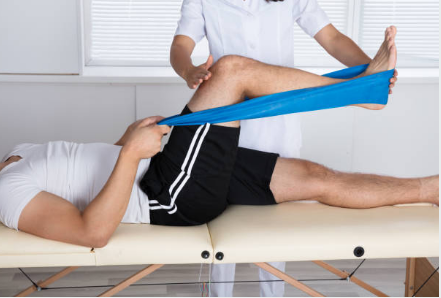Iliotibial Band Syndrome (ITBS), commonly known as IT Band Syndrome, is one of the most frequent overuse injuries experienced by runners, cyclists, and other athletes. It manifests as pain on the outside of the knee, and while it might seem like a minor issue at first, if left untreated, it can become a persistent and debilitating condition. This blog post delves into the causes, symptoms, and treatment options for IT Band Syndrome, offering insight into how to manage and prevent this common injury.
What is IT Band Syndrome?
The iliotibial (IT) band is a thick band of connective tissue that runs along the outside of the thigh, from the hip to the shin. It plays a crucial role in stabilizing the knee during running and other activities. IT Band Syndrome occurs when this band becomes tight or inflamed, causing friction as it rubs against the lateral femoral epicondyle, a bony prominence on the outside of the knee.
Causes of IT Band Syndrome

IT Band Syndrome typically results from a combination of factors that contribute to increased tension or strain on the IT band. The following are the most common causes:
- Overuse and Repetitive Motion:
- Repeated flexion and extension of the knee, as seen in activities like running and cycling, can lead to overuse of the IT band. This repetitive motion can cause the band to tighten and become irritated.
- Weak Hip Muscles:
- Weakness in the hip muscles, particularly the gluteus medius, can result in poor pelvic control and increased tension on the IT band. This can lead to altered biomechanics and excessive strain on the knee.
- Improper Training Techniques:
- Sudden increases in training intensity, duration, or frequency can overload the IT band. This is especially common among athletes who do not allow adequate time for recovery.
- Biomechanical Issues:
- Structural or biomechanical issues, such as leg length discrepancies, flat feet, or excessive pronation (inward rolling of the foot), can contribute to IT Band Syndrome. These conditions can alter the alignment and movement patterns of the lower limbs, leading to increased stress on the IT band.
- Inadequate Warm-Up and Stretching:
- Failing to properly warm up before exercise or neglecting to stretch the muscles around the IT band can increase the risk of developing IT Band Syndrome.
- Poor Running Form:
- Running with improper form, such as overstriding or excessive heel striking, can place additional stress on the IT band and contribute to the development of IT Band Synd
int.
Symptoms of IT Band Syndrome

-
- The primary symptom of IT Band Syndrome is pain on the outside of the knee. This pain typically worsens with activity and may gradually increase in intensity. Other symptoms include:
- Localized Pain:
- Sharp or burning pain on the outer part of the knee, often described as stabbing or aching. This pain may radiate up or down the leg and can be exacerbated by activities such as running, walking, or cycling.
- Swelling:
- Swelling or inflammation may occur around the knee, particularly on the outside of the joint. This can cause additional discomfort and limit movement.
- Tenderness:
- Tenderness to touch along the IT band, particularly at the point where it crosses the knee joint, is a common symptom. Pressing on this area may reproduce the pain.
- Snapping Sensation:
- Some individuals may experience a snapping or popping sensation as the IT band moves over the knee joint during activity. This is often a sign of tightness or irritation in the IT band.
- Pain with Downhill Running:
- Pain may be particularly noticeable when running downhill, as this increases the strain on the IT band and knee joint. The downhill motion can cause the IT band to rub more intensely against the bone, leading to increased pain.
- Limited Mobility:
- Stiffness or limited range of motion in the knee, making it difficult to fully extend or flex the joint, is another common symptom of IT Band Syndrome.
- Localized Pain:
- The primary symptom of IT Band Syndrome is pain on the outside of the knee. This pain typically worsens with activity and may gradually increase in intensity. Other symptoms include:
Diagnosing IT Band Syndrome

If you suspect you have IT Band Syndrome, it is important to seek a proper diagnosis from a healthcare professional. The diagnosis typically involves:
-
-
- Medical History:
- A review of your medical history, including your activity levels, training habits, and any previous injuries, is essential in identifying the potential causes of IT Band Syndrome.
- Physical Examination:
- A physical examination will involve palpation of the IT band and surrounding structures, as well as specific tests to reproduce the pain. These tests can help determine the severity of the condition and identify any contributing factors.
- Imaging:
- In some cases, imaging studies such as MRI or ultrasound may be used to rule out other conditions, such as ligament injuries or stress fractures. These imaging techniques can also provide detailed information about the soft tissues around the knee.
- Medical History:
-
Treatment Options for IT Band Syndrome
Treatment for IT Band Syndrome focuses on reducing pain and inflammation, addressing the underlying causes, and preventing recurrence. Here’s how you can manage and treat IT Band Syndrome:
- Rest and Activity Modification:
- Reducing or temporarily stopping activities that aggravate the pain, such as running or cycling, is crucial for allowing the IT band to heal. Rest is essential to avoid further irritation of the IT band.
- Ice Therapy:
- Applying ice to the affected area can help reduce inflammation and numb the pain. Ice therapy should be applied for 15-20 minutes several times a day, particularly after activities that exacerbate the pain.
- Stretching Exercises:
- Regular stretching of the IT band, as well as the muscles of the hip, thigh, and lower leg, can help alleviate tightness and improve flexibility. Specific stretches targeting the glutes, quadriceps, and hamstrings are particularly beneficial.
- Foam Rolling:
- Using a foam roller to massage the IT band and surrounding muscles can help release tension and reduce discomfort. Foam rolling should be done regularly, focusing on the outside of the thigh where the IT band is located.
- Strengthening Exercises:
- Strengthening the hip abductors, gluteal muscles, and core can improve pelvic stability and reduce stress on the IT band. These exercises help correct muscle imbalances and improve overall biomechanics.
- Correcting Biomechanical Issues:
- Addressing any biomechanical issues, such as leg length discrepancies or improper footwear, is essential. Custom orthotics, shoe inserts, or changes in running technique may be recommended to improve alignment and reduce stress on the IT band.
- Physiotherapy:
- A physiotherapist can provide a tailored exercise program, manual therapy, and education on proper biomechanics. They may also use techniques such as ultrasound or dry needling to reduce pain and inflammation.
- Anti-Inflammatory Medications:
- Nonsteroidal anti-inflammatory drugs (NSAIDs) can help manage pain and reduce inflammation. These medications should be used under the guidance of a healthcare professional.
- Gradual Return to Activity:
- Once symptoms have improved, a gradual return to activity is recommended. This involves slowly increasing the intensity and duration of exercise, with careful monitoring of any recurrence of pain.
- Surgical Intervention:
- In rare cases where conservative treatment fails, surgery may be considered to release the IT band or address any underlying structural issues. This option is typically reserved for severe cases that do not respond to other treatments.
Preventing IT Band Syndrome
Preventing IT Band Syndrome involves taking proactive steps to minimize the risk of injury. Here are some tips to help you stay injury-free:
- Warm-Up and Cool-Down:
- Always start your workouts with a proper warm-up and finish with a cool-down, including stretching exercises for the IT band and surrounding muscles. This helps prepare your muscles and joints for activity and reduces the risk of injury.
- Strength Training:
- Incorporate strength training exercises into your routine to build strong hip and core muscles, which provide stability and reduce strain on the IT band. Focus on exercises that target the glutes, quadriceps, and hamstrings.
- Gradual Progression:
- Avoid sudden increases in training intensity, duration, or frequency. Gradually build up your workouts to allow your body to adapt to the increased demands. This helps prevent overuse injuries like IT Band Syndrome.
- Proper Footwear:
- Wear shoes that provide adequate support and cushioning for your feet. Replace worn-out shoes regularly, and consider using orthotics if you have specific biomechanical issues. Proper footwear is crucial for maintaining good alignment and reducing stress on the IT band.
- Cross-Training:
- Incorporate low-impact activities like swimming or cycling into your routine to reduce the repetitive stress on your IT band. Cross-training helps maintain fitness while giving your IT band a break from high-impact activities like running.
- Listen to Your Body:
- Pay attention to any early signs of discomfort or pain on the outside of your knee. Rest and address these symptoms early to prevent the development of IT Band Syndrome.
IT Band Syndrome is a common but preventable injury that can significantly impact your ability to engage in physical activity. Understanding the causes, symptoms, and treatment options is essential for effective management and prevention. Whether you’re a runner, cyclist, or someone who enjoys an active lifestyle, taking steps to protect your IT band can help you stay healthy and injury-free.
If you’re experiencing symptoms of IT Band Syndrome, consider consulting a healthcare professional or physiotherapist to develop a personalized treatment plan. With the right care and attention.






